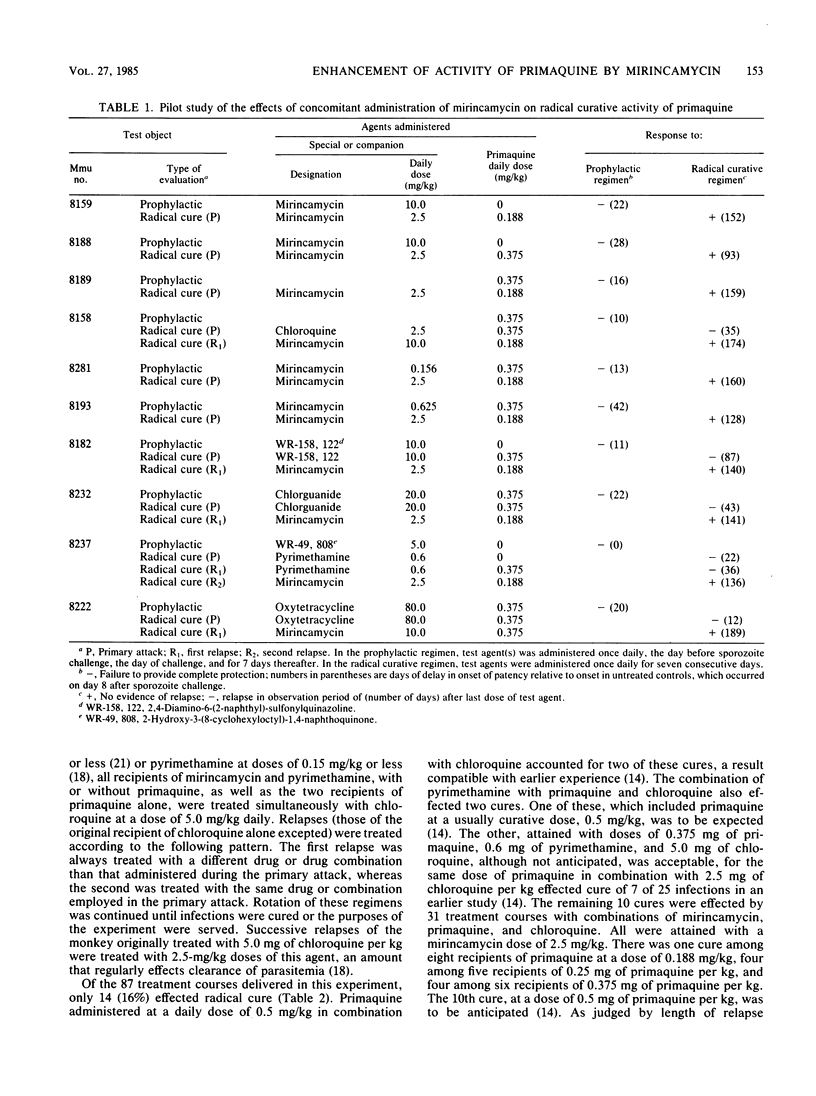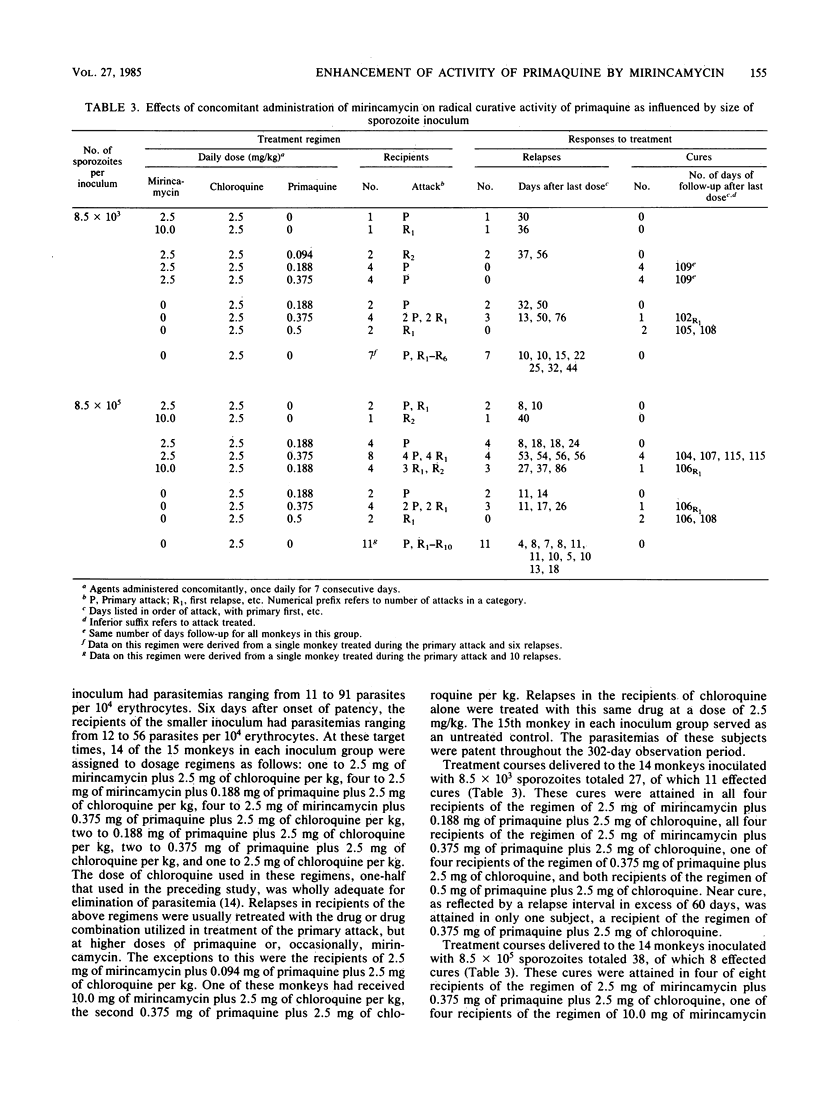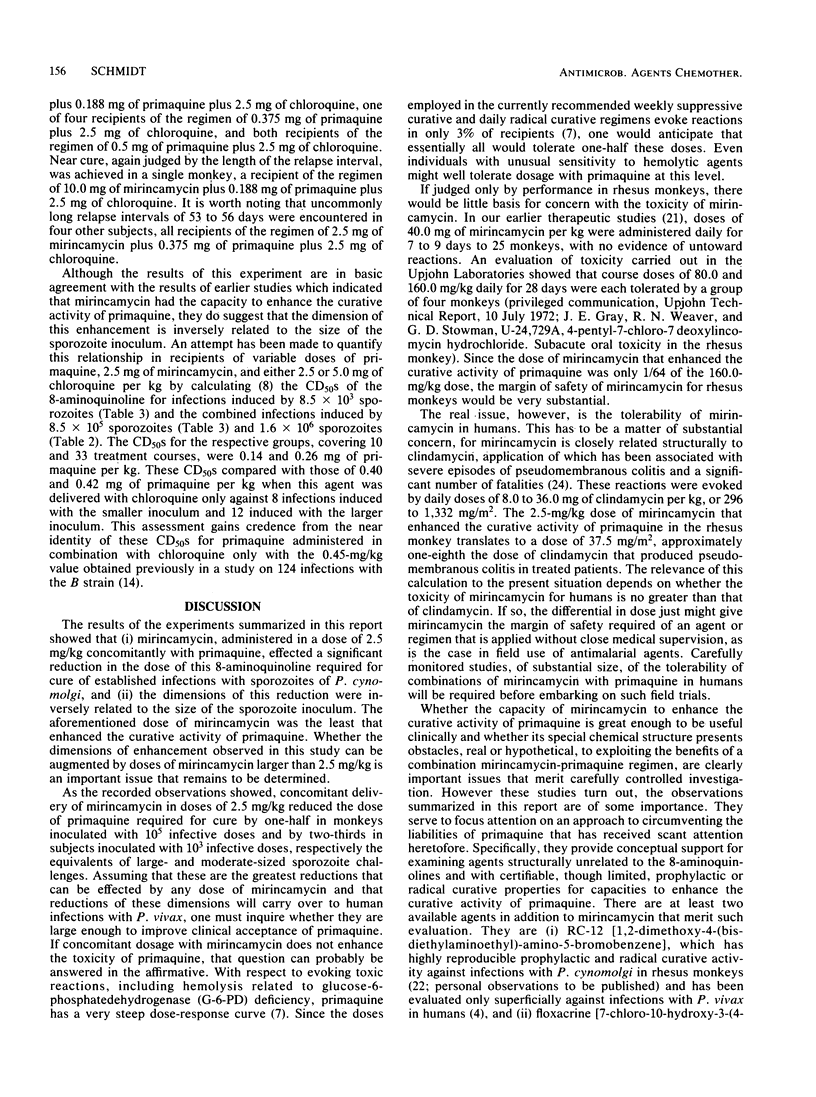Abstract
Mirincamycin, a lincomycin derivative with unequivocal but limited activity against the pre-erythrocytic and persisting exoerythrocytic stages of Plasmodium cynomolgi, has been evaluated for capacity to enhance the radical curative potential of the conventional primaquine-chloroquine combination. Established infections with sporozoites of the above plasmodium in rhesus monkeys served this evaluation. The results showed that the dose of primaquine required for cure of 50% of active infections was reduced by one-half to two-thirds by coadministration with 2.5 mg of mirincamycin per kg, 1/16 the 50% curative dose of this lincomycin derivative when used in a mono-drug regimen. The dimensions of the enhancement of the curative activity of primaquine were inversely related to the size of the sporozoite inoculum. The smallest dose of mirincamycin productive of enhancement was 2.5 mg/kg; whether doses larger than 2.5 mg/kg would have been more effective was not determined. There is much to be done before it is known whether a mirincamycin-primaquine combination is useful for suppressive cure or radical cure of the human malarias. Irrespective of that result, the current study serves to focus attention on a somewhat novel approach to the development of more effective and better-tolerated regimens for radical cure, an alternative to the empirical chemical synthesis and screening approach that has dominated searches heretofore.
Full text
PDF






Selected References
These references are in PubMed. This may not be the complete list of references from this article.
- Barrett O., Jr, Skrzypek G., Datel W., Goldstein J. D. Malaria imported to the United States from Vietnam. Chemoprophylaxis evaluated in returning soldiers. Am J Trop Med Hyg. 1969 Jul;18(4):495–499. doi: 10.4269/ajtmh.1969.18.495. [DOI] [PubMed] [Google Scholar]
- Barrett O., Jr The problem of vivax malaria in Vietnam returnees. Mil Med. 1968 Mar;133(3):211–214. [PubMed] [Google Scholar]
- EYLES D. E., COATNEY G. R. Effect of certain drugs on exoerythrocytic parasites of Plasmodium cynomolgi. Am J Trop Med Hyg. 1962 Mar;11:175–185. doi: 10.4269/ajtmh.1962.11.175. [DOI] [PubMed] [Google Scholar]
- Fisher G. U., Gordon M. P., Lobel H. O., Runcik K. Malaria in soldiers returning from Vietnam. Epidemiologic, therapeutic, and clinical studies. Am J Trop Med Hyg. 1970 Jan;19(1):27–39. doi: 10.4269/ajtmh.1970.19.27. [DOI] [PubMed] [Google Scholar]
- JONES R., Jr, JACKSON L. S., DI LORENZO A., MARX R. L., LEVY B. L., KENNY E. C., GILBERT M., JOHNSTON M. N., ALVING A. S. Korean vivax malaria. III. Curative effect and toxicity of primaquine in doses from 10 to 30 mg. daily. Am J Trop Med Hyg. 1953 Nov;2(6):977–982. [PubMed] [Google Scholar]
- Magerlein B. J., Kagan F. Lincomycin. 8. 4'-Alkyl-1'-demethyl-4'-depropylclindamycins, potent antibacterial and antimalarial agents. J Med Chem. 1969 Sep;12(5):780–784. doi: 10.1021/jm00305a013. [DOI] [PubMed] [Google Scholar]
- Magerlein B. J. Lincomycin. 14. An improved synthesis and resolution of the antimalarial agent, 1'-demethyl-4'-depropyl-4'-(R)- and -(S)-pentylclindamycin hydrochloride (U-24, 729A). J Med Chem. 1972 Dec;15(12):1255–1259. doi: 10.1021/jm00282a013. [DOI] [PubMed] [Google Scholar]
- Powell R. D. Chemoprophylaxis and malaria in American servicemen returning from Vietnam. Am J Trop Med Hyg. 1978 Jan;27(1 Pt 1):1–5. [PubMed] [Google Scholar]
- SCHMIDT L. H., GENTHER C. S. The antimalarial properties of 2, 4-diamino-5-p-chlorophenyl-6-ethylpyrimidine, daraprim. J Pharmacol Exp Ther. 1953 Jan;107(1):61–91. [PubMed] [Google Scholar]
- Schmidt L. H. Antimalarial properties of floxacrine, a dihydroacridinedione derivative. Antimicrob Agents Chemother. 1979 Oct;16(4):475–485. doi: 10.1128/aac.16.4.475. [DOI] [PMC free article] [PubMed] [Google Scholar]
- Schmidt L. H. Appraisals of compounds of diverse chemical classes for capacities to cure infections with sporozoites of Plasmodium cynomolgi. Am J Trop Med Hyg. 1983 Mar;32(2):231–257. doi: 10.4269/ajtmh.1983.32.231. [DOI] [PubMed] [Google Scholar]
- Schmidt L. H. Comparative efficacies of quinine and chloroquine as companions to primaquine in a curative drug regimen. Am J Trop Med Hyg. 1981 Jan;30(1):20–25. doi: 10.4269/ajtmh.1981.30.20. [DOI] [PubMed] [Google Scholar]
- Schmidt L. H., Harrison J., Ellison R., Worcester P. The activities of chlorinated lincomycin derivatives against infections with Plasmodium cynomolgi in Macaca mulatta. Am J Trop Med Hyg. 1970 Jan;19(1):1–11. doi: 10.4269/ajtmh.1970.19.1. [DOI] [PubMed] [Google Scholar]
- Schmidt L. H. Relationships between chemical structures of 8-aminoquinolines and their capacities for radical cure of infections with Plasmodium cynomolgi in rhesus monkeys. Antimicrob Agents Chemother. 1983 Nov;24(5):615–652. doi: 10.1128/aac.24.5.615. [DOI] [PMC free article] [PubMed] [Google Scholar]
- Schmidt L. H., Rossan R. N., Fradkin R., Woods J., Schulemann W., Kratz L. Studies on the antimalarial activity of 1,2-dimethoxy-4-(bis-diethylaminoethyl)-amino-5-bromobenzene. Bull World Health Organ. 1966;34(5):783–788. [PMC free article] [PubMed] [Google Scholar]
- Skrzypek G., Barrett O., Jr The problem of vivax malaria in Vietnam returnees. II. Malaria chemoprophylaxis survey. Mil Med. 1968 Jun;133(6):449–452. [PubMed] [Google Scholar]


